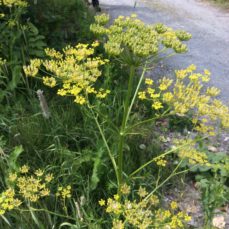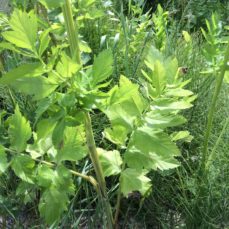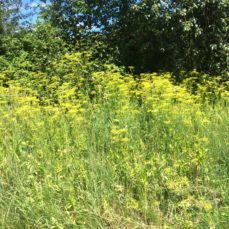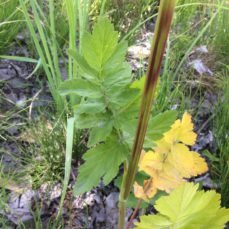
Management Strategy
Squamish
Whistler
Pemberton
Vectors of Spread
Synonyms
Alternate common names:
- Common parsnip
- Parsnip
- Bird’s nest
- Poison parsnip
- Hart’s eyes
Alternate scientific names:
- Elaphoboscum sativum
- Pastinaca fleischmannii
- Pastinaca sativa sylvestris
- Pastinaca sylvestris
- Peucedanum pastinaca
- Peucedanum sativum
ID Characteristics
General: Wild parsnip is a stout, aromatic biennial or short-lived perennial, member of the carrot family (Apiaceae).
Flowers: Yellow (or rarely white) and grouped in umbrella-shaped clusters (called umbels), with 15 – 25 unequal spokes per umbel (10 – 20 cm wide). Flowers have five petals.
Stem: Erect, up to 2 m tall. Wild parsnip stems are grooved and covered in sparse hairs.
Leaves: Alternate, pinnately compound, branched and have saw-toothed edges. Leaves are each composed of 5 – 15 mitten-shaped, toothed leaflets. Basal leaves are up to 40 cm long and 20 cm wide; the size of the leaves decreases up the stems.
Seeds: Elliptic, about 5 mm long, flat and hairy.
Roots: Wild parsnip has a thick, long, yellow-brown taproot.
Similar Species
Invasive

Giant hogweed (Heracleum mantegazzianum), which is much taller than wild parsnip.

Wild carrot (or Queen Anne’s lace, Daucus carota) and wild chervil (Anthriscus sylvestris) are also part of the carrot family they have white flowers, unlike wild parsnip.
You can learn more about how to tell members of the carrot family apart here.
Habitat and Origin
Wild parsnip was introduced from Europe as a root crop. It is worth noting that wild parsnip is extremely similar to cultivated parsnip varieties and is considered part of the same plant species.
Wild parsnip can tolerate various soil types, from heavy clay to sandy loam. It thrives in partial to full sun, but it does not tolerate shade. Wild parsnip is usually found in ditches, forest clearings, abandoned fields and meadows, as well as on disturbed areas such as roadsides, railways and trails.
How it Spreads
Wild parsnip reproduces both vegetatively (via rhizomes) and by seed. Plants produce about 2,000 fruits in a season, and the seeds remain viable in the soil for up to 4 years. Wild parsnip is considered a biennial or monocarpic perennial: it spends one or more years as a basal rosette before flowering, setting seed and dying.
Short-distance dispersal occurs by wind and water. Long-distance spread can be caused by accidental hay or straw contamination; landscaping, farming and soil movement activities; or accidental escape from agricultural fields and vegetable gardens.
Impacts
Wild parsnip is toxic and can cause skin blisters. It is best to seek the help of a professional to control it.
Health:
- Skin contact with leaves or stems can cause photosensitivity (photodermatitis), resulting in severe blistering when exposed to sunlight.
Ecological:
-
- Outcompetes native species, reducing biodiversity.
- Honeybees do not visit the plant; displaces other pollinator-friendly plants.
- Hosts several diseases, including brown rot and parsnip mosaic virus.
Economic:
- Reduces the quality and saleability of crops like hay, oats, and alfalfa.
- Leaves and stems are toxic to livestock.
Stop the Spread
Wild parsnip is found in the Sea to Sky region, but with a limited distribution. The goal is to eradicate this species from the region, and to prevent new introductions.
Learn to identify wild parsnip: use the images presented on this page to learn how to identify wild parsnip
What to do if you spot it: You can report any wild parsnip sighting by visiting our reporting page..
DO:
- Regularly monitor properties for weed infestations.
- Ensure soil and gravel are uncontaminated before transport.
- Ensure that plants are disposed of in a garbage bag if found in floral arrangements to prevent seeds from spreading.
DO NOT:
- Unload, park or store equipment or vehicles in infested areas; remove plant material from any equipment, vehicles or clothing used in such areas and wash equipment and vehicles at designated cleaning sites before leaving infested areas.
- Plant wild parsnip in a garden, no matter how well-contained its enclosure may seem.
- Move soil that has been contaminated with wild parsnip.
Control
Wild parsnip is toxic and can cause skin blisters. It is best to seek the help of a professional to control it.
Mechanical
- Always wear full personal protective equipment when treating wild parsnip to protect yourself from the toxic sap.
- Small infestations can be hand-pulled (ensure you remove the roots).
- Mowing before flowering can prevent seed production but re-sprouting is likely.
- Larger infestations (where digging up is not feasible) can be mowed and subsequently covered with tarps.
Burning does not control wild parsnip populations directly, but periodic burning can encourage the growth of native fire-tolerant species which may outcompete wild parsnip over time. However, caution must be taken if burning an area containing Wild Parsnip, as burning can release sap into the air, potentially causing severe reactions to people downwind.
Chemical
- Glyphosate, metsulfuron-methyl/aminopyralid, 2,4-D, and chlorsulfuron/aminocyclopyrachlor are effective on wild parsnip.
- Picloram is also effective, but it is not suitable for wet, coastal soils.
- Rosettes or adult plants can be individually spot-sprayed with glyphosate.
- We recommend that any herbicide application is carried out by a person holding a valid BC Pesticide Applicator Certificate. Before selecting and applying herbicides, you must review and follow herbicide labels and application rates; municipal, regional, provincial and federal laws and regulations; species-specific treatment recommendations, and site-specific goals and objectives.
Biological
There are many species that will feed on wild parsnip, but most do not cause enough damage to the plant to provide control.
Sea to Sky Distribution
Wild Parsnip Factsheet
Having trouble viewing the factsheet? Don’t worry, all the information is included on this page. You can also contact us with any questions.
Additional Resources
References
- Alberta Invasive Species Council, Wild Parsnip Factsheet
- Central Kootenay Invasive Species Society, Wild Parsnip
- Electronic Atlas of the Flora of BC, Pastinaca sativa
- Fraser Valley Invasive Species Society, Wild Parsnip
- Invasive Species Centre, Wild Parsnip (Pastinaca sativa)
- Invasive Species Council of BC, Wild Parsnip Factsheet
- Lillooet Regional Invasive Species Society, Wild Parsnip
- Minnesota Department of Agriculture, Wild Parsnip
- Nature Conservancy Canada, Wild parsnip
- Nottawasaga Valley Conservation Authority, Wild Parsnip
- Ontario Invasive Plant Council, Wild Parsnip Best Management Practices in Ontario
- Ontario’s Invading Species Awareness Program, Wild Parsnip
- Southeastern Wisconsin Invasive Species Consortium, Wild Parsnip















